When we look at the ocean, it can be easy to get overwhelmed by all of the animals that reside in our waters. The number of animals underwater alone is too much, let alone fish. While estimations are 3.5 trillion fish, there is no definitive way to tell how many there are.
As we make our way through the alphabet, we have landed on the letter E. Can you guess how many fish there are in the entire world whose common names start with the letter “E”? We can’t either! So, we have compiled a list of 85+ fish whose common names start with “E.”
After we dive into ten fish that start with “E” and learn about their size and habitats, we will then move on to a comprehensive list we have compiled, where we can also learn their scientific names along with their common names.
Let’s start with one of the largest fish out there, the escolar fish.
Escolar (Lepidocybium flavobrunneum)

The escolar fish is known to be caught by tuna fisheries.
Escolar (Lepidocybium flavobrunneum) of the family Gempylidae is a rather large fish that can grow as long as seven feet and weigh up to 99 pounds!
These large fish will pretty on squid, cuttlefish, crustaceans, and other smaller fish. The escolar has two distinct prey: the yellowfin tuna and humans.
The reason that humans are one of the top prey is because humans will eat this fish. Escolar is very nutritional. While nutritional, you don’t want to eat too much.
Emperor Angelfish (P. imperator)
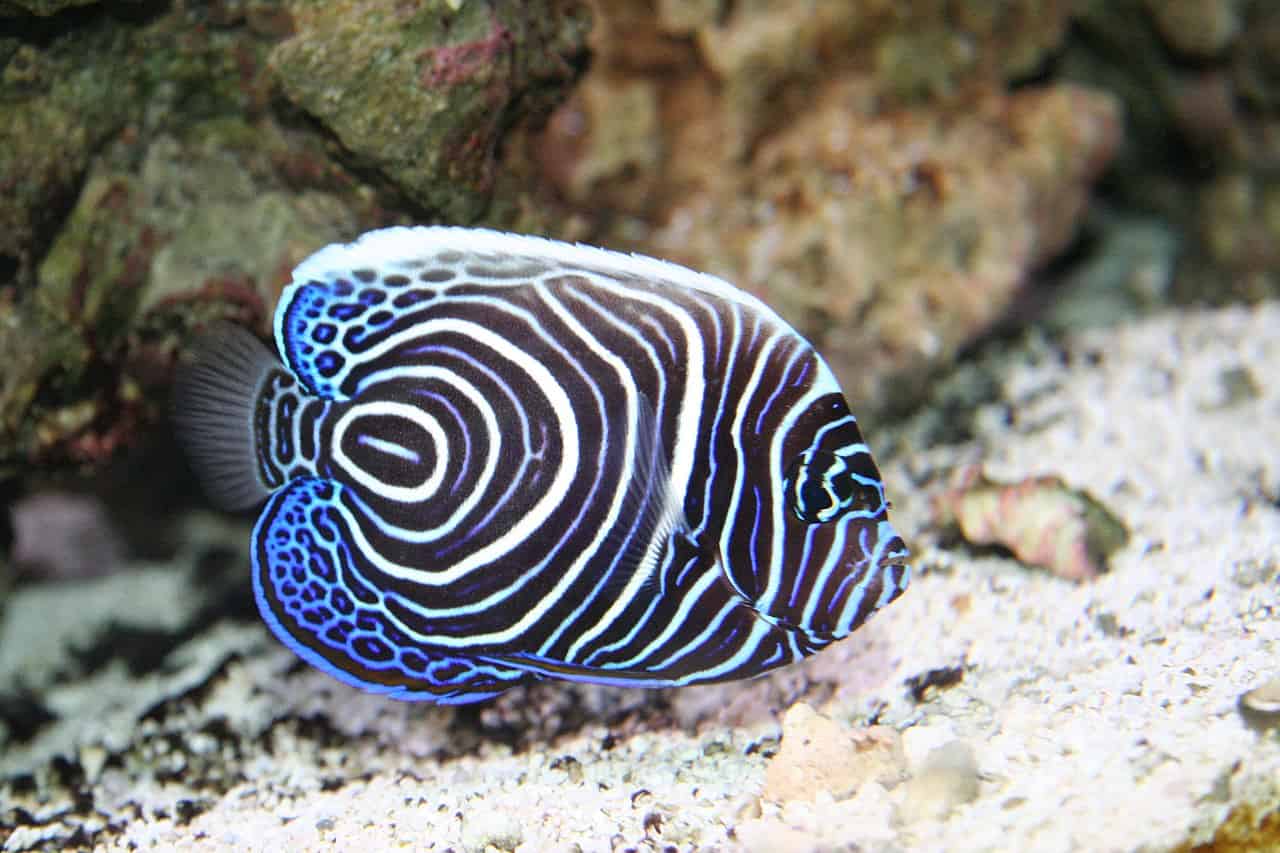
The Emperor
angelfish’s
beautiful scales and colors allow them to attract other emperor angelfish so they can mate with them.
©Vic Brincat (cadmanof50s) from Keswick, Ontario, Canada, CC BY 2.0, via Wikimedia Commons – License
Emperor angelfish (P. imperator) are solitary animals that have very colorful stripes on their scales. Oddly enough, they are labeled as one of the most beautiful fish in the ocean. They are yellow, blue, black, and white in appearance.
This fish can grow to 16 inches in length. However, most emperor angelfish are only 10-15 inches in length.
They prey on tunicates. Tunicats are marine invertebrate animals. Sharks, marine mammals, and larger fish will prey on the emperor angelfish.
Ember Tetra (Hyphessobrycon amandae)

The bright colors of the ember tetra make them desirable fish to keep in aquariums.
©nektofadeev/Shutterstock.com
This beautifully orange-colored fish, the ember tetra (Hyphessobrycon amandae), is known as one of the smallest shoaling fish in the world. Shoaling means fish that hang out in the same place in groups.
These small fish reach 0.8 inches in size. Due to this, they will feast on small invertebrates and crustaceans. Their top food choice as omnivores, however, is zooplankton.
These little fish will live a very short lifespan of all 2-4 years. Their main predators are various larger fish—one of the top predators is the cichlids.
Elephant Fish (Callorhinchus milii)
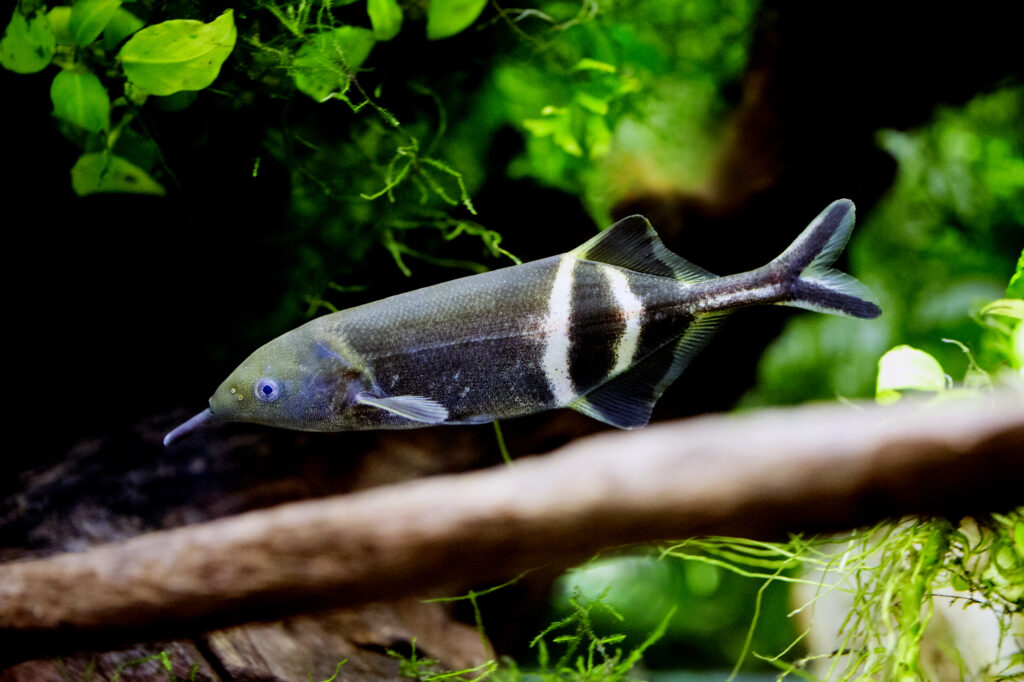
The
elephant
fish is brown, blue, and black in appearance. They have a long snout that resembles an elephant’s trunk.
©boban_nz/Shutterstock.com
Elephant Fish (Callorhinchus milii) of the family Chimaeriformes has the common name elephant fish for its long snout that can extend far out. These fish are only about 2-4 feet long and weigh 10-15 pounds. Large elephant fish can grow to as much as 20 pounds in total.
These fish are very slow and only move about two miles per hour. They feast on mollusks and crustaceans.
They are solitary animals and a constant food source for sharks.
Electric Eel (Electrophorus electricus)
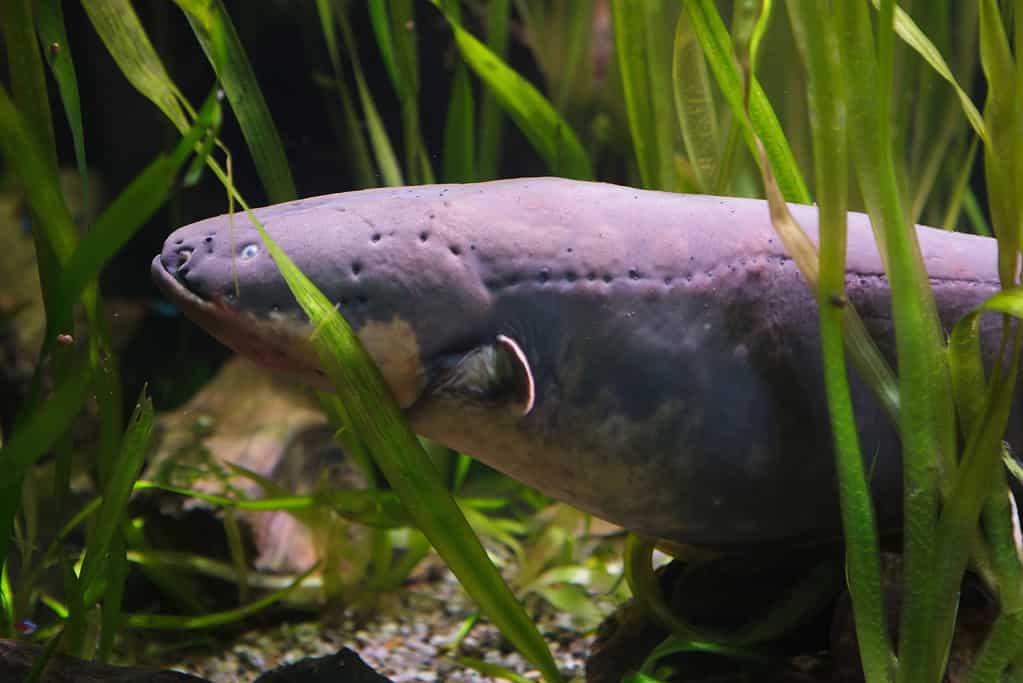
The electric eel likes to reside in murky waters. Their habitats are particularly in South America.
©Vladimir Wrangel/Shutterstock.com
The electric eel (Electrophorus electricus) has three species within its family, Gymnotidae. These three species are the electric eel (Electrophorus electricus), Vari’s electric eel (E. varii), and Volta’s electric eel (E. voltai).
Electric eels range in size according to their species; however, most electric eels are around 45 pounds and reach up to eight feet long.
They feast on fish, insects, small vertebrates, and crustaceans. Due to the electric voltage electric eels can produce, there are no predators for these fish. After all, who wants to be electrocuted while eating?
Electric Catfish (Malapteruridae)
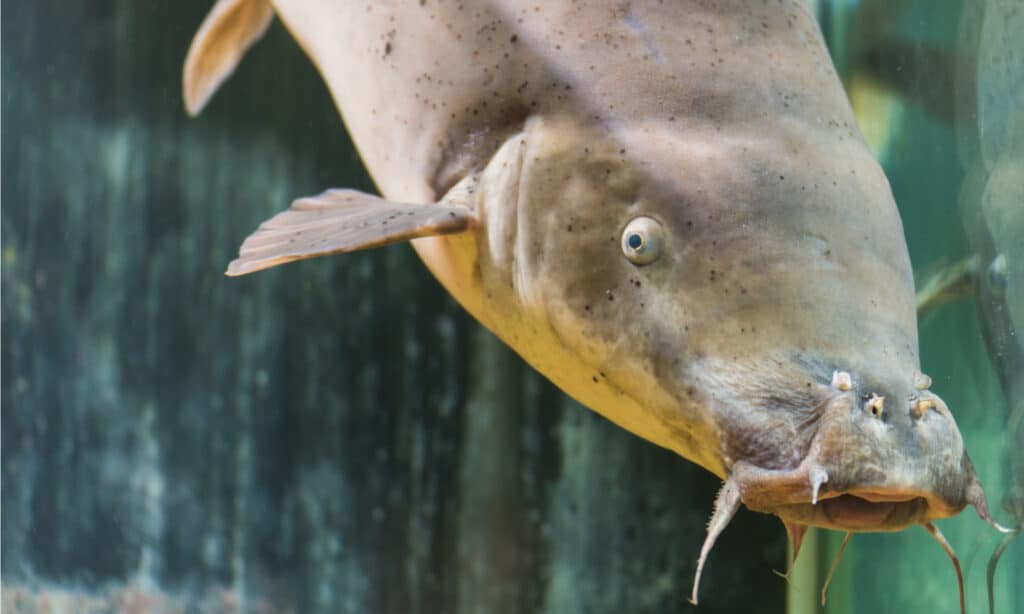
The electric
catfish
are generally gray-brown on the back and sides.
©BLUR LIFE 1975/Shutterstock.com
Electric catfish (Malapteruridae) find its natural habitat residing in freshwater around Africa. Weighing approximately two pounds and reaching four feet, these fish are rather big when you think about their length compared to other fish.
The electric catfish, as a carnivore, likes to each fish, invertebrates, and eggs. As far as predators go, other larger fish will eat them.
An interesting fact about these catfish is that they can discharge up to 450 volts to shock their predators. This type of shock would certainly be dangerous, if not fatal, to a human.
To put this in perspective, a typical house in the United States would have about 240 volts of electricity flowing through its house. Imagine what 240 volts could do, and now see that the electric catfish has double that!
Eelpout (Zoarces viviparus)
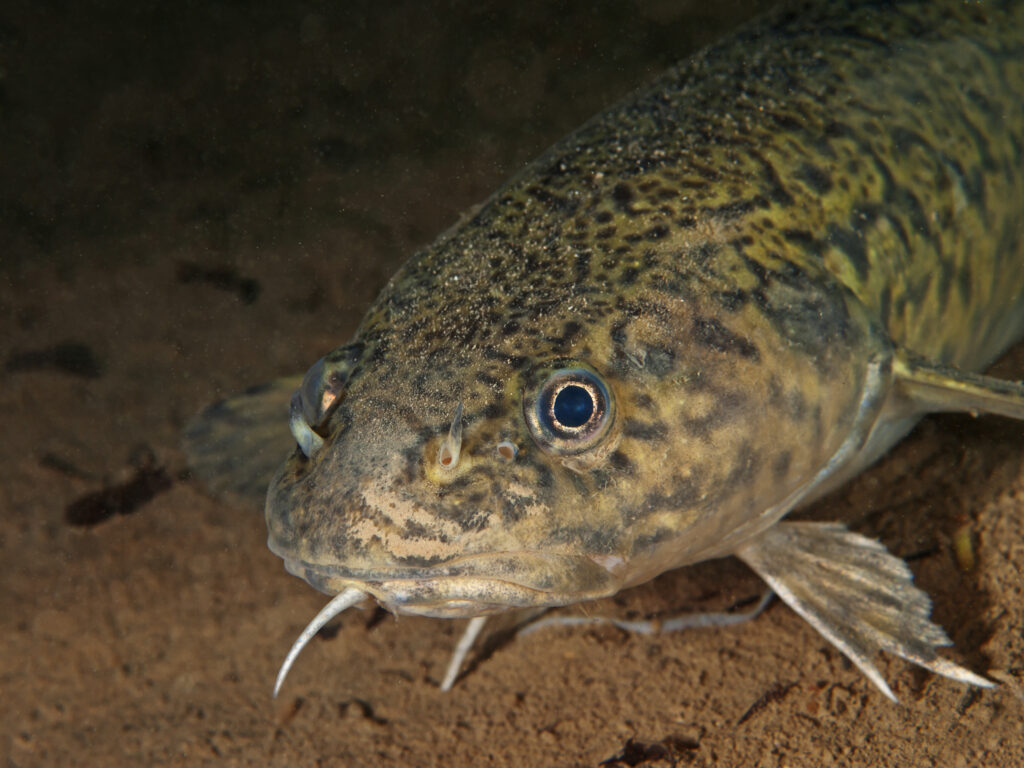
All marine eelpouts belong to the order Scorpaeniformes. This diverse order of ray-finned fish includes over 1,320 species
©scubaluna/Shutterstock.com
A rather blah-looking fish, the eelpout (Zoarces viviparus) is a carnivore that preys on sea urchins, sea cucumbers, starfish, sand dollars, crabs, and shrimp.
These fish are worldwide. And as such, they have a variety of predators, such as seals, skates, and sculpins.
There are approximately 296 different species of eelpout fish. And they all share one distinct feature, they have large fleshy-looking lips.
Eel (Anguilliformes)
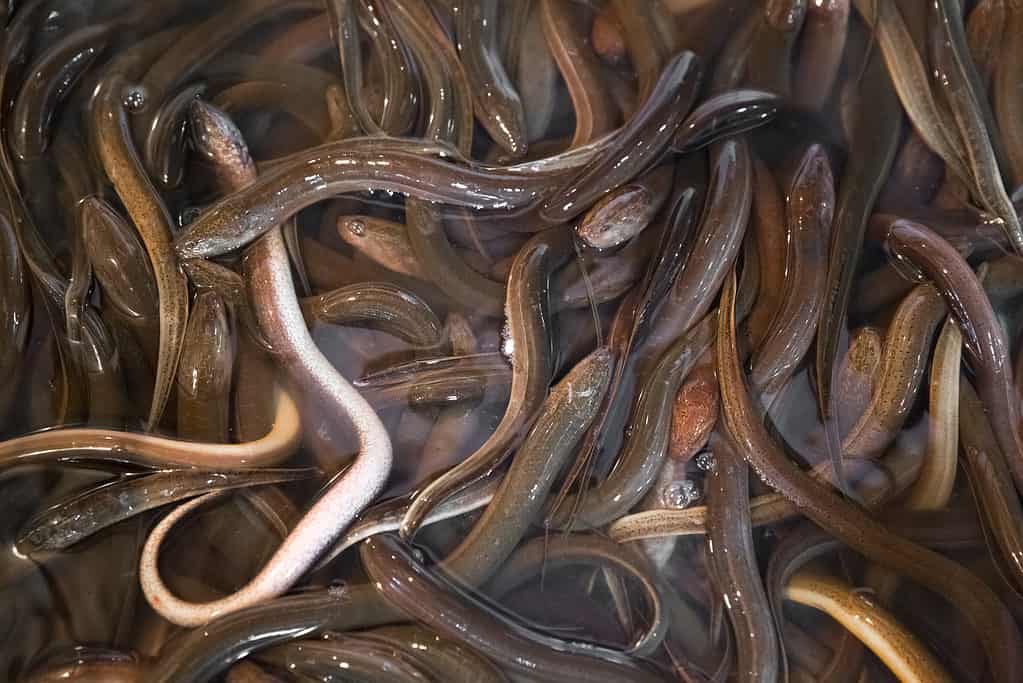
Not only is it safe for humans to eat eel, it is a delicacy many countries prize.
©Valentin Ayupov/Shutterstock.com
Eel (Anguilliformes) of the class Actinopterygii can be found in various locations all around the world. Their habitats reside in locations such as Africa, Asia, Central America, Eurasia, Europe, North America, and South America, to list a few locations.
These eels can grow to be 13 feet long! For as long as they are, they do have slender bodies that only reach about 25 kilograms (55 pounds).
The eel catfish likes to feast on smaller fish, invertebrates, crustaceans, shrimp, crabs, and sea urchins.
Eagle Ray (Myliobatidae)

A spotted eagle ray is seen while scuba diving over the reef near Cozumel Mexico, in the National Marine Park.
©iStock.com/eaglerayjoel
The eagle ray (Myliobatidae) is a fish you might see at your local aquarium. They have smooth skin and appear grey, blue, black, and white in appearance.
The eagle ray is both a solitary and a school animal that preys on crustaceans and mollusks. School means that they would live in a large group. If you’ve ever seen the movie Finding Nemo, this would be a good example of a school of fish that you see mid-movie when Nemo’s dad is searching for him!
Largest Fish that Starts with the Letter “E”
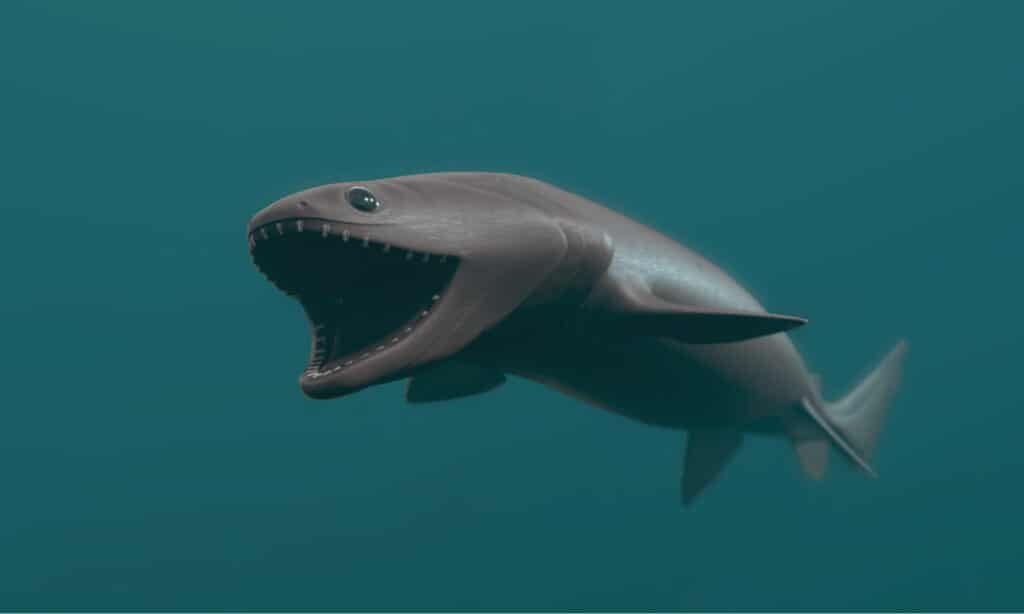
The
frilled shark
, more commonly referred to as the eel shark, has fringed-like gills that gave it its common name the “frilled shark. Their eel-like appearance is why they are also known as the eel shark.
©iStock.com/3dsam79
The list of fish we have provided above, and then the comprehensive list below, does not even begin to cover all the common names out there for fish that start with the letter “E.” We scoured our list and found one of the largest fish in the ocean, a shark resembling an eel.
The frilled shark is more commonly referred to as the eel shark (Chlamydoselachus anguineus) due to its eel-like appearance when you first look at it.
This large shark can grow up to 200 pounds. The males are shorter, normally growing to only 5.6 feet. While the females are a foot longer, coming in at 6.6. feet long.
A lot of sharks have a very smooth-like appearance, such as the great white shark. However, the eel shark (frilled shark) has a very fringed-like appearance with its gills. Thus, he is known as the frilled shark.
The eel shark (frilled shark) will prey on cephalopods, bony fish, and other smaller sharks.
Now that we have looked at the basics of 10 fish that start with the letter “E” and looked at one of the largest fish that start with “E,” we are now ready to delve right into a complete list of 85+ fish where their common names start with “E” and listing their scientific names.
Complete List of 85+ Fish That Start with the Letter “E”
| Common Name (Fish that start with “E”) | Scientific Name |
|---|---|
| Emperor Angelfish | Pomacanthus imperator |
| Eel | Anguilliformes |
| Electric Eel | Electrophorus |
| Elephant Fish | Gnathonemus petersii |
| European Minnow | Phoxinus phoxinus |
| Eagle Ray | Myliobatidae |
| European Flounder | Platichthys flesus |
| Electric Catfish | Malapteruridae |
| Escolar | Lepidocybium flavobrunneum |
| European Perch | Perca fluviatilis |
| Eel Loach | Pangio kuhlii |
| Eastern Spiny Gurnard | Lepidotrigla pleuracanthica |
| Edible Gourami (giant gourami) | Osphronemus goramy |
| Eastern Spiny Seahorse | Hippocampus hendriki |
| Eastern Banded Catshark | Atelomycterus marnkalha |
| Easter Island Flying Fish | Cheilopogon rapanouiensis |
| Eastern Cleaner-Clingfish | Cochleoceps orientalis |
| Eelpout | Zoarcidae |
| Eel-Goby | Taenioides cirratus |
| Eastern Clingfish | Cochleoceps orientalis Hutchins |
| Emperor Bream | Lethrinidae |
| Eeltail Catfish | Plotosidae |
| Eastcoast Squeaker | Synodontis zanzibaricus |
| Eastern River Garfish | Hyporhamphus regularis ardelio |
| Eastern Silvery Minnow | Hybognathus regius |
| Eastern Bream | Abramis brama |
| Elephantnose Fish | Gnathonemus petersii |
| Eastern Paradise Fish | Macropodus opercularis |
| Ember Parrotfish | Scarus rubroviolaceus |
| Espe’s Pencilfish | Nannostomus espei |
| Eastern Spotted Gummy Shark | Mustelus walkeri |
| Earth Eater | Geophagus sp. |
| Eucla Cod | Euclichthys polynemus |
| Ethiopian Lungfish | Protopterus aethiopicus |
| Eight-Barb Loach | Eirmotus octozona |
| Electric Ray | Torpediniformes |
| European Chub | Squalius cephalus |
| Empire Gudgeon | Hypseleotris compressa |
| Emerald Catfish | Corydoras splendens |
| European Wels | Silurus glanis |
| European Eel | Anguilla anguilla |
| Emperor Tetra | Nematobrycon palmeri |
| Ebinania Macquariensis | Macquarie blobfish |
| Eastern Rainbow Fish | Melanotaenia splendida splendida |
| Eastern Bottlenose Mormyrid | Mormyrus caschive |
| Electric Knifefish | Electrophorus electricus |
| Eastern Pomfred | Schuettea scalaripinnis |
| Eastern Mudminnow | Umbra pygmaea |
| Eastern Leg Skate | Sinobatis filicauda |
| Elasmobranch | Elasmobranchii |
| Eel Cod | Muraenolepididae |
| Easter Damselfish | Chrysiptera rapanui |
| Ebinania Costaecanariae | Ebinania Costaecanariae |
| Elegant Rasbora | Rasbora elegans |
| Eulachon | Thaleichthys pacificus |
| Electric Yellow Hap | Labidochromis caeruleus |
| Eastern Blue Devil | Paraplesiops bleekeri |
| Elephant-Nose Cichlid | Gnathonemus petersii |
| Entsuyui | Earthworm Eel |
| Earthworm Eel | Chaudhuriidae |
| Ebinania Vermiculata | Ebinania vermiculata Sakamoto |
| Eastern Australian Blackhead Triplefin | Enneapterygius atrogulare |
| Eastern Smooth Boxfish | Anoplocapros inermis |
| Emperor | Lethrinus miniatus |
| Eye Spot Loach | Acanthocobitis botia |
| Everglades Pygmy Sunfish | Elassoma zonatum |
| Egyptian Mouthbrooder | Pseudocrenilabrus multicolor |
| Eye-Lined Pyrrhulina | Pyrrhulina rachoviana |
| Eastern Starhead Topminnow | Fundulus dispar |
| Eel catfish | Channallabes apus |
| Ember Tetra | Hyphessobrycon amandae |
| Eared blacksmelt | Lipolagus ochotensis |
| Eared conger | Castleichthys auritus |
| Earle’s soldierfish | Myripristis earlei |
| Earle’s splitfin | Luzonichthys earlei |
| Earspot cusk eel | Ophidion fulvum |
| Earspot snakeblenny | Ophiclinops hutchinsi |
| East African red finned barb | Barbus apleurogramma |
| East African sardinella | Sardinella neglecta |
| East China leg skate | Anacanthobatis donghaiensis |
| East coast crocodilefish | Cymbacephalus beauforti |
| Ebinania malacocephala | Ebinania malacocephala Nelson |
| Ebosia falcata | Falcate lionfishes |
| Ecsenius fourmanoiri | Ecsenius fourmanoiri |
| Egyptian sole | Solea aegyptiaca |
The photo featured at the top of this post is © Rich Carey/Shutterstock.com
Thank you for reading! Have some feedback for us? Contact the AZ Animals editorial team.






